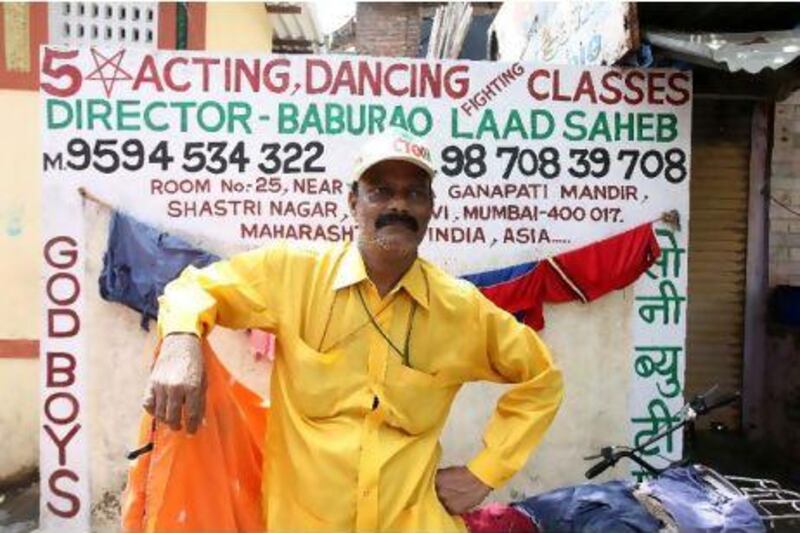MUMBAI // In a windowless one-room flat deep inside one of India's largest slums, Baburao Ladsaheb shouts to be heard over the sound system blaring a dance tune from a popular Bollywood movie.
Mr Ladsaheb, a lean man with a balding head and an overgrown moustache, sports a yellow shirt. On his head is a cap that reads "Director". Sweat pours down his face as he demonstrates dance steps and keeps rhythm for a group of eight men learning how to dance.
Asking them to imitate the motions, he shouts: "Wipe the glass...5...6...7...8. Thread the needle...1...2...3...4. Slap left. Slap Right. Double slap...Double slap. The hips must move at all times - the way you pedal a bicycle."
Mr Ladsaheb, 49, runs 5 Star Acting Dancing Fighting Classes. For the past 25 years, he has taught residents of Dharavi how to be backup dancers and gangsters for jobs in Bollywood films.
"I struggled, and there was no one to guide me out of these slums and in to the movies, so I decided to teach," he said.
Mr Ladsaheb started his career as a backup dancer, making his way up to regional cinema. After acting in at least 15 Marathi and Bhojpuri films, including small roles in Bollywood, he produced, directed and acted in a Marathi film called Baburao Mhantoya Mithya Maruya (Baburao Says Let's Embrace) last year, where he played 11 roles. The film, shot entirely in his neighbourhood, is a story about religious unity.
"The film didn't do as well as expected," he said. "But the message got out. Even from the slums can rise actors, directors and thinkers."
Gone are the years when he would try to find placements for his students. Bollywood casting directors now come to Mr Ladsaheb when they need people to play patients in a hospital, slum dwellers, or beggars.
"They want the look, we have the look," said Mr Ladsaheb. "Only here, in these slums, will you find whatever you are looking for."
Sunday's three-hour weekly dance and acting classes cost 500 rupees (Dh33) a month. For serious would-be stars, he offers courses lasting up to five years aimed at preparing them for any role.
Most, however, opt for three to six-month courses that he calls "short and sweet, because everyone is in a hurry to be in a film".
Some of the skills he teaches seem to exist only in the Indian entertainment lexicon. For models, he purports to offer lessons in "how to model a chunari, or scarf", "how to pose with a biscuit" and "hair oil modelling".
The painted signboard outside his flat lists over a hundred different skills under five genres: acting, western dance, classical dance, modelling and fighting.
He teaches sword, knife, Hollywood, Bollywood fighting; high jumping, short jumping, and how to deliver dialogue while taking a punch.
Over the years, the fighting aspect of the classes have taken a toll on his 30-square-metre flat where he teaches. Students have smashed into his television set at least twice, and have broken the mirrors more time than he can recall.
Between the mock fight routines he yelled: "The TV set! Be Careful!...1...2...3...4."
According to Mr Ladsaheb, an actor must know horse riding, swimming, modelling, lip synching as well as singing, driving, dancing and fighting.
"No one listens when I give advice" said Mr Ladsaheb. "They just want to learn technique, technique, technique."
On the wall are portraits of his students who have made it big. Most had roles in television dramas. His greatest success was a woman who landed a lead role in a Bollywood film in the 1980s.
But those who come to him have less lofty ambitions.
"I grew up dreaming of being a backup dancer - dancing behind a big star," said Mohammed Mehmuddin Ansari, 18, a tailor in Dharavi.
He has been taking classes for the past two months in the hopes of achieving his goal.
Praveen Patel, 19, dreams of being a supporting actor. He came back for additional classes after completing the three-month course.
"I need to build stamina and endurance," he said.
Mr Ladsaheb constantly cautions his students that actors shoot for eight hours at a time, while television actors work for twice as long.
"If you make a mistake, you are put in the back," he tells the aspiring backup dancers who are taking a break. "If you make another mistake in the back, you go home."
Mr Ladsaheb bemoaned what he said was the inability of students to dedicate themselves to acting.
"They are distracted easily these days. They can't get off the phone for two hours to come attend a class. They take calls during sessions," he said.
Sometimes parents accompany their children to monitor their progress.
Tushar Pramod Sawan, 18, from Dharavi, wanted to learn classical Indian dance and be a backup dancer but his father, Pramod Gopal Sawan, 43, was there to ensure his entertainment education was well-rounded.
"He must learn fighting and acting as well," said Mr Sawan. "I want him to be an actor."
Tushar's father has his own reasons for pushing his son to aim higher. "When I was 15," said Mr Sawan, "I was picked to play a villain's henchman, a sidekick to the movie's bad guy, but my mother did not let me go."
"So when my son started winning awards in school and college for dance, I thought it was time to make the dream come true."





